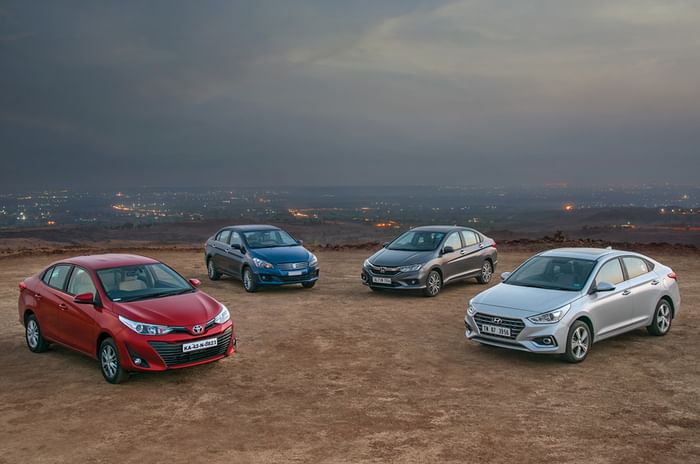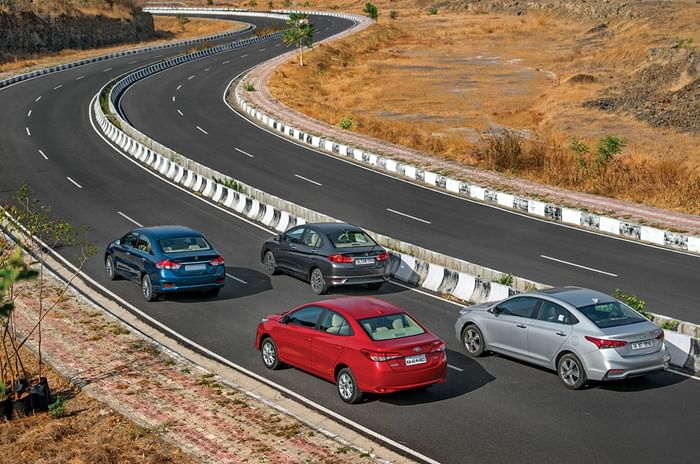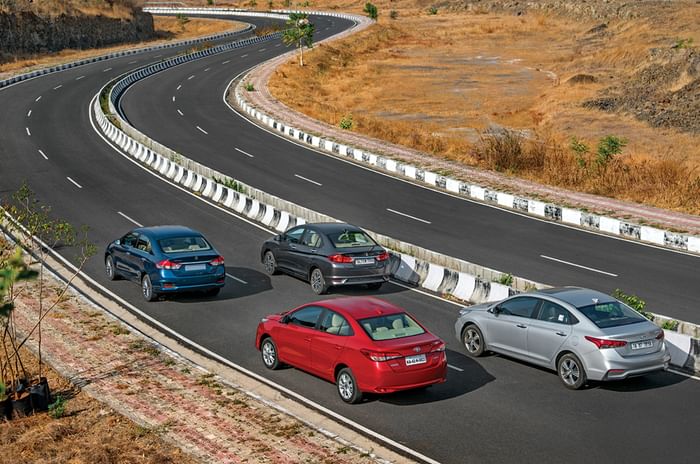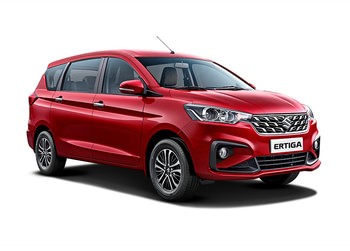2018 Yaris vs Verna vs City vs Ciaz comparison
The Toyota Yaris has been in the news, but how does the new mid-size sedan fare against the Hyundai Verna, Honda City and the Maruti Suzuki Ciaz?
Published on Jun 14, 2018 02:45:00 PM
1,77,966 Views
Follow us on

Let’s cut to the chase. The reason the Hyundai Verna, Honda City and Maruti Suzuki Ciaz are here is because they are the bestselling mid-size sedans in India. By extension, that means, for a majority of buyers in the segment, these are also the models the new Toyota Yaris will be judged against. And walkovers they are not.
Hyundai’s latest Verna finally has the substance to go with its style, while the Honda City got an update last year to make it the most appealing it’s ever been. Maruti Suzuki’s competent Ciaz has been in the news for other reasons. It’s now being sold through the premium Nexa retail outlets, and come August, will get a facelift and a new petrol engine. But given that the current Ciaz sales are showing no signs of tailing off, it’s still very relevant in this comparison.
In focus are the petrol-manual versions of these cars, which are the most popular variants in the model range. Toyota has priced the base version of the Yaris competitively at Rs 8.75 lakh (ex-showroom, Delhi) but the top-end VX in consideration here costs Rs 12.85 lakh. Compare that to the Hyundai Verna SX(O)’s Rs 11.42 lakh, Honda City VX’s Rs 12.06 lakh and Maruti Suzuki Ciaz Alpha’s Rs 9.7 lakh, and you will see the Toyota Yaris is the most expensive car here. Is it good enough to justify the extra spend, or do any of the other three provide a better alternative?
What are they like on the outside?
A few years ago, Toyota’s boss Akio Toyoda promised ‘no more boring cars’. But, in look, the Yaris seems caught in the transformation from old Toyota to new Toyota. The basic shape and design is safe, but the nose – though striking and radical by Toyota standards – doesn’t quite gel convincingly with the rest of the car. Think middle-aged man with a landing strip goatee, and you’ll get the idea. The large headlights and blacked-out portion of the bumper work as individual elements, but then there’s nothing remarkable at the rear, and the small 15-inch wheels also give the Yaris a less-than-perfect stance.
While Toyota has strived for flamboyant styling on the Yaris, Hyundai, formerly known for its flamboyant designs, has gone for a ‘less is more’ approach with the new Verna. There are no exaggerated cuts and creases here, and, in fact, the styling is neat and tidy and it looks more like a heavily facelifted version of the previous model than an all-new design. The Verna’s ‘cascading grille’ and swept-up headlamps look good, the roof is nicely arced and the tail-lights with their LED signatures are really eye-catching.

The Maruti Suzuki Ciaz is also ageing quite gracefully. It’s a smartly turned-out sedan, even though its styling leans towards the conservative side; the upcoming facelift promises to add a bit of flash to the look. The Ciaz does manage to look quite substantial, though; it’s the longest and widest sedan here, and also has the largest wheelbase. The Yaris matches the Ciaz on width but is the shortest in length. Interestingly, the City and Verna are identical in length and wheelbase.
While Toyota has strived for flamboyant styling on the Yaris, Hyundai, formerly known for its flamboyant designs, has gone for a ‘less is more’ approach with the new Verna. There are no exaggerated cuts and creases here, and, in fact, the styling is neat and tidy and looks more like a heavily facelifted version of the previous model than an all-new design. The Verna’s ‘cascading grille’ and swept-up headlamps look good, the roof is nicely arced and the tail-lights with their LED signatures are really eye-catching.
LED headlights, meanwhile, are the talking point on the facelifted City. They not only provide excellent illumination but also add another dose of modernity to its arrow-shot design. Last year’s update also brought with it a new chrome-rich grille, and new, premium-looking alloy wheels that do their bit to help hide the City’s four-year vintage.
The Maruti Ciaz is also ageing quite gracefully. It’s a smartly turned-out sedan, even though its styling leans to the conservative side; perhaps the upcoming facelift will add a bit of flash to the look. The Ciaz does manage to look quite substantial, though. It’s the longest and widest sedan here, and also has the largest wheelbase. The Yaris matches the Ciaz on width but is the shortest in length. Interestingly, the City and Verna are identical in length and wheelbase.
| Dimensions | ||||
|---|---|---|---|---|
| Toyota Yaris VX MT | Hyundai Verna 1.6 VTVT SX(O) | Honda City 1.5 i-VTEC VX | Maruti Suzuki Ciaz K14 Alpha | |
| Length | 4425mm | 4440mm | 4440mm | 4490mm |
| Width | 1730mm | 1729mm | 1695mm | 1730mm |
| Height | 1495mm | 1475mm | 1495mm | 1485mm |
| Wheelbase | 2550mm | 2600mm | 2600mm | 2650mm |
| Tyre size | 185/60 R15 | 195/55 R16 | 185/55 R16 | 195/55 R16 |
| Boot capacity | 476 litres | 480 litres | 510 litres | 510 litres |
| Kerb weight | 1120kg | 1143kg | 1084kg | 1025kg |
What are they like on the inside?
These cars carry their exterior personalities on the inside as well. So, where the Toyota Yaris’s cabin has some overdone elements, the Hyundai Verna’s is smart, the Honda City’s is modern and the Maruti Suzuki Ciaz’s is neat.
The Yaris’ dash looks unique and is sensibly designed, with the infotainment screen positioned high up on the centre console. Other nice bits include the climate control console and the 4.2-inch multi-info display at the dials. The segment-first eight-way-adjustable powered driver’s seat is also a pleasant addition, though you still have to contend with a narrow footwell and the absence of a dead pedal. Also, for all its use of beige materials, the cabin never looks or feel premium enough. The larger plastics are hard and shiny, and the mock ‘stitching’ on the steering is unconvincing. Build quality, however, is pretty good.
It is the Hyundai Verna, though, that, with its doors shutting with a reassuring thunk, feels the best built. Cabin quality levels are also the best here and it’s things like the knitted roof lining that make all the difference. The dash is neatly laid out and is quite low to afford a reasonably good view out. You sit quite low here and the seats aren’t the largest around, but on a hot summer’s day, you are sure to have high praise for its unique front-seat ventilation function.
Seat comfort is an area the Honda City aces the rest, and how. The front seats are large and perfectly cushioned, and the inclusion of a telescopic steering wheel adjust also helps achieve a spot-on driving position. With the facelift, Honda spruced up the City’s cabin with some soft-touch plastics on the dash, but overall quality isn’t at Verna levels. The asymmetrical dash divides opinion too, and that cool-looking touchscreen for the climate control system is actually a bit distracting to use on the go.
You won’t find anything out of the ordinary in the Maruti Suzuki Ciaz. The dash is simple in design and quality levels are fair, but look closely and you’ll find some plastic panels don’t align perfectly and that some of the switches come from lesser Marutis. Front-seat comfort is good but taller drivers will find the seat set too high even at its lowest position.

In the back, it’s the Ciaz that can give more expensive models a run for their money with the legroom it offers. But the thing is, this class-leading leg space doesn’t translate to class-leading comfort. The rear seats are firm, the squab is short and headroom is just average too. Without a doubt, it’s the City that offers the best comfort at the back. Legroom is second only to the Ciaz, but the seats are way more comfortable, and that upward sloping floor that serves as a natural footrest, takes things up a notch. It’s also the car best suited to seating three abreast.
The Yaris and Verna are no match for the City and Ciaz for cabin room, and just don’t offer the same sense of space either. In fact, there are compact sedans more spacious than the Verna. Make your peace with the space on offer, especially the very limited headroom, and you’ll find the Hyundai’s seat nice and appreciate the inclusion of adjustable rear-seat headrests.
Note that the Yaris is the only car with a rear centre headrest and a proper three-point seat belt for the middle passenger. But the front centre armrest extends so far back, it actually eats into middle passenger legroom, and the backrest too is a bit upright. And what of its Innova-like roof-mounted rear air-con vents? Well, the location rules out the possibility of a sunroof but is actually the most effective at channelling cool air to the back, and it’s the only unit that lets you adjust fan speed at the back too.
Charging points for the rear passengers are always handy and are included in all these cars, though the City and Yaris go one up by offering two ports.
How do they compare on features?
The top-spec Toyota Yaris VX is the most expensive of these mid-size sedans, but it does get quite a few class-first features to justify its price. There’s a powered driver’s seat adjust, front parking sensors, rain-sensing wipers, and even a tyre pressure monitoring system. However, the single area where the Yaris pulls a lead over its rivals is in safety. Seven airbags are commendably standard across the range, and higher versions see the addition of rear disc brakes, while top versions also get the safety net of electronic stability programme and hill start assist. And although the results don’t directly apply in India, there’s some satisfaction in knowing the Yaris scored a 5-star rating in the ASEAN NCAP crash test.
 Front seat ventilation a cool touch on Verna.
Front seat ventilation a cool touch on Verna.
The Hyundai Verna in top SX(O) trim is quite content rich in its own right. It misses out on the Yaris’ electronic aids but comes with six airbags, and is also the only car here with ventilated front seats and hands-free boot release. Also part of the kit is a sunroof, something you’d find on the Honda City VX too.
The other features of note on the City VX are its LED headlights and tilt and telescopic adjust for the steering. Still, it’s a shame that Honda doesn’t sell the City petrol-manual in the top-spec ZX trim. The top-spec cars get auto headlights and wipers, and see the addition of side and curtain airbags.
The Maruti Suzuki Ciaz makes do with the least number of goodies and feels pared down amidst rivals. You, however, can’t hold that against it because it’s not just thousands of rupees but lakhs cheaper than its rivals. It gets the modern-day essentials, but it’s odd that lesser vehicles in Maruti’s line-up actually feature more kit. Maruti Suzuki will rectify the situation with the upcoming facelift, and the spied cars have been spotted with cruise control.
Common to all these cars are leather seats, rear air-con vents, keyless go and touchscreen infotainment systems. In the battle of the infotainment systems, the Verna’s unit comes up trumps. It’s the best to use and comes loaded with Android Auto, Apple CarPlay and MirrorLink. Honda’s DigiPad system is good but not great, though we expect it to be only a matter of time before the more advanced and friendlier DigiPad 2.0 from the new Amaze makes its way onto the City too. The Yaris’ system is unique in the fact that it supports gesture controls for basic functions. But it’s quite temperamental and a bit gimmicky to be honest, and the rest of the interface is also nothing to write home about. Ciaz buyers get Maruti Suzuki’s simple and straightforward SmartPlay system. It’s fair for usability but scores big points for its support of Android and Apple’s projection systems.

Short throws make the Honda's gearbox a joy to use.
| Price and equipment | ||||
|---|---|---|---|---|
| Toyota Yaris VX MT | Hyundai Verna 1.6 VTVT SX(O) | Honda City 1.5 i-VTEC VX | Maruti Suzuki Ciaz K14 Alpha | |
| Price (ex-showroom, Delhi) | Rs 12.85 lakh | Rs 11.42 lakh | Rs 12.06 lakh | Rs 9.7 lakh |
| LED headlights | NA | NA | Yes | NA |
| Auto headlamps/wipers | Yes/Yes | Yes/NA | NA/NA | NA/NA |
| Tyre pressure monitor | Yes | NA | NA | NA |
| Cruise control | Yes | Yes | Yes | NA |
| Android Auto/Apple CarPlay | NA/NA | Yes/Yes | NA/NA | Yes/Yes |
| Leather seats | Yes | Yes | Yes | Yes |
| Powered driver’s seat | Yes | NA | NA | NA |
| Ventilated front seats | NA | Yes | NA | NA |
| Rear air con vents | Yes | Yes | Yes | Yes |
| Sunroof | NA | Yes | Yes | NA |
| Front/rear parking sensors | Yes/Yes | NA/Yes | NA/NA | NA/Yes |
| Rear-view camera | Yes | Yes | Yes | Yes |
| ESP | Yes | NA | NA | NA |
| Airbags | 7 | 6 | 2 | 2 |
How do they compare on performance?
There’s a 30hp difference in power between the most powerful car here and the least powerful one. We’ll get to each one by one, but what you should know is that all these cars make use of four-cylinder, naturally aspirated petrol engines.
The Toyota Yaris’s 1.5-litre engine’s 107hp and 140Nm puts it smack in the middle of the power and torque charts. It’s an easygoing engine that also does its work quietly. Performance is fine for keeping up with the flow of city traffic but ask any more of it, and the Yaris fails to make an impression. The mid-range is meek, so you’ll often reach out for the gear lever to downshift to get by traffic. Its performance numbers corroborate our findings – the Yaris takes the most time to 100kph from a standstill, and its in-gear timings are also slowest across the board.

The City is quickest to 100kph but it’s the Verna that’s quicker through the gears.
The Hyundai Verna, on the other hand, comes a close second, if it isn’t already the quickest accelerating car in a particular gear. It helps that the Hyundai’s 123hp and 151Nm, 1.6-litre engine is the largest, most powerful and torquiest one here. The Verna feels peppy in town and its power characteristics also make it feel the most flexible; so you can get away with driving in a higher gear without protest from the engine. That the engine runs smooth and quiet (it’s the quietest here) is also a big plus here.
Quite the opposite is the Honda City’s engine – it’s the most audible one here. It’s the loudest at idle and on the go, but ardent petrolheads might actually like the ‘raw’ sound and nature of the engine. Because when you open it up, few mass market car engines excite like Honda’s 119hp and 145Nm 1.5 i-VTEC unit. It’s a hoot from 4,500rpm on to its 7,000rpm limiter, and the strong top-end is partly responsible for the City’s class-best 0-100kph time of 10.13sec. However, in more everyday driving scenarios, the City takes some time to get into its stride, which is a bit of a downer.
With a humdrum 92hp and 130Nm from its 1.4-litre engine, you’d expect the Maruti Suzuki Ciaz to feel quite dull. But the big surprise is that it’s actually the most alert and responsive to throttle inputs in the lower gears, which works great in the daily traffic grind. The Ciaz’s light 1,025kg kerb weight undoubtedly helps low-speed performance. Try upping the pace, and suddenly the engine comes across as unidimensional. Power delivery is flat, the mid-range is dull and there’s nothing exciting in store in the top-end either. You particularly feel the lack of zing out on the highway.
All the models come with light clutches and nice gearboxes, but it’s the Honda’s setup that feels the sportiest, goading you to try out a quick shift every now and then. The Yaris and Verna make use of six-speed gearboxes, while the City and Ciaz come with five-speed units. Unexpectedly though, it was the cars with the five-speeders that delivered better fuel economy numbers. Leading the pack is the Ciaz, followed closely by the City. The Yaris and Verna’s single-digit fuel economy figures in town are sure to be a concern for many buyers in these times of record-high fuel prices.
| Powertrain & performance | ||||
|---|---|---|---|---|
| Toyota Yaris VX MT | Hyundai Verna 1.6 VTVT SX(O) | Honda City 1.5 i-VTEC VX | Maruti Suzuki Ciaz K14 Alpha | |
| Engine | 4 cyls, petrol | 4 cyls, petrol | 4 cyls, petrol | 4 cyls, petrol |
| Displacement | 1496cc | 1591cc | 1497cc | 1373cc |
| Power | 107hp at 6000rpm | 123hp at 6400rpm | 119hp at 6600rpm | 92hp at 6000rpm |
| Torque | 140Nm at 4200rpm | 151Nm at 4850rpm | 145Nm at 4600rpm | 130Nm at 4000rpm |
| Transmission | 6-speed manual | 6-speed manual | 5-speed manual | 5-speed manual |
| 0-20kph | 1.13s | 1.09s | 1.24s | 1.37s |
| 0-40kph | 2.92s | 2.68s | 2.5s | 2.83s |
| 0-60kph | 5.33s | 4.84s | 4.44s | 5.27s |
| 0-80kph | 8.32s | 7.47s | 6.95s | 7.9s |
| 0-100kph | 12.39s | 11.18s | 10.13s | 12.02s |
| 0-120kph | 17.51s | 15.67s | 14.64s | 16.68s |
| 0-140kph | 25.06s | 22.21s | 19.93s | 24.24s |
| 20-80kph (in third gear) | 14.74s | 11.71s | 12.82s | 11.32s |
| 40-100kph (in fourth gear) | 20.43s | 15.56s | 17.22s | 16.2s |
| Fuel economy (city/highway) | 9.6/16.4kpl | 9.2/13.5s | 11.0/17.0kpl | 11.5/17.2kpl |

How do they compare on ride and handling?
The four cars use electric power steering, and front MacPherson struts and rear torsion beam suspension arrangements. The Toyota Yaris exhibits a hint of firmness at low speeds, but the setup bodes well at higher speeds, where it feels controlled in its body movements, and there’s plenty of grip too. But the steering that’s relatively heavy at low speeds, also feels artificially weighted at high speeds and just doesn’t give a very connected experience.
A disconnected driving experience was synonymous with the last-gen Hyundai Verna. The latest one? It’s almost like it’s taken a two-generation leap in the right direction. Sure, the steering is still not the last word in feel, but body control and high-speed manners are actually the best amongst this quartet. The class-best overall refinement just ups that feeling of comfort. The Verna is good in town too, with a steering that’s easy to twirl and a suspension that ably filters out most surface imperfections.
The Honda City is the stiffest sprung car here. There’s always that little bit of up-down movement and the suspension doesn’t completely shield you against the bumps. It’s good then that the City’s seats are as comfy as they are. But the Honda, once again, has something for keen drivers. It’s steering is reasonably quick (vis-à-vis the others), if not totally feelsome, so there’s some fun to be had chucking the car into a corner.

Ciaz peppiest of the lot at town speeds. Yaris only average on performance.
Maruti Suzuki Ciaz drivers will rarely feel the urge to do the same. Body control is actually quite alright, but the steering feels just too numb. And like all new Marutis, the self-centring is inconsistent. What is nice is the ride. It rides like a much heavier car and feels quite planted, and the suspension is absorbent and quiet.
Which one should you buy?
The Toyota Yaris is a car that does many things well without being great at any one thing in particular. It comes across as a bit vanilla, and just doesn’t have the pull a mid-size sedan with a Toyota badge on it should have. Sure, safety levels are best in class and there are quite a few goodies on the top-spec trim too, but it is simply pricey by class standards.
At the other end of the spectrum is the Maruti Suzuki Ciaz that plays the value card with aplomb. It’s the most spacious, it’s peppy in town, and happens to be the most efficient too. You do get a lot of car for the money, just not the best car. Its boring engine and the absence of many features make it the value choice, but little more. The upcoming facelift, however, could change things very soon.

If you are going to be primarily sat at the back, or have frequent use of the rear seats, the Honda City is the car for you. The rear seat is easily the best in class. Enthusiasts will also like the engine for its top-end performance, but the Honda isn’t perfect. It’s the noisiest of the lot, not fully awake at low city speeds, and is also on the expensive side for what it gets you.
The Hyundai Verna it is then. It’s a car that tops the scoring sheets across many parameters and offers the most feel-good experience when talking quality, refinement and general driving manners. If the limited rear-seat space and mediocre fuel economy are not deal breakers for you, the Verna is quite simply the best petrol-manual mid-size sedan you can buy today.
Location Courtesy: Khed City Industrial Park, Pune
Toyota Yaris V trim used for photography only.
Copyright (c) Autocar India. All rights reserved.






















.jpg?w=234&h=156&q=90&c=1)



Comments
Member Login
Personal Details
No comments yet. Be the first to comment.